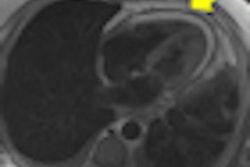Pediatricians who perform routine brain MRI scans on their patients need a plan to deal with findings that reveal unexpected but benign anomalies that are unlikely to cause problems, according to study published online June 14 in the journal Pediatrics.
Senior investigator John Strouse, MD, PhD, a hematologist at Johns Hopkins Children's Center in Baltimore, said doctors need to know what, if anything, they want to share with patients about such findings, because they seldom require urgent follow-up.
The patients in the Hopkins study all had sickle cell disease and were predominantly African-American. They received brain MRI scans before enrolling in the research study about their condition. None of the brain anomalies discovered in the study was related to the patient's underlying condition, so the study findings may apply to healthy children in general.
Researchers enrolled 953 children between the ages of 5 and 14; 63 patients (6.6%) had a total of 68 abnormal brain findings. None of the children required emergency treatment or follow-up and only six children (0.6%) needed urgent follow-up.
The urgent findings involved changes suggestive of slow-growing tumors and a structural defect in which brain tissue extends into the spinal canal. None of the six children with urgent findings had any clinical symptoms suggestive of the anomalies.
Because discovery of unexpected findings, especially ones of unclear clinical significance, can lead to fear and more tests that are often unnecessary, the Hopkins study emphasizes the need for pediatricians to prepare for such discussions.
In the absence of guidelines on how to deal with such findings, many pediatricians feel so unprepared that they may forego the discussion altogether and simply refer the patient to a neurologist or neurosurgeon for consultation, the authors noted.
Twenty-five children (2.6%) required only routine follow-up for spinal cord anomalies or minimal brain tissue protrusion into the spinal canal. In addition, 32 children (3.4%) required no follow-up for a benign anatomic anomaly marked by the presence of a thin membrane separating the lateral ventricles of the brain.
Other abnormalities included brain cysts and cortical dysplasia, a condition in which certain nerve cells form abnormally in the wrong part of the brain and can lead to seizures.
By Wayne Forrest
AuntMinnie.com staff writer
June 14, 2010
Related Reading
Simulation can replace sedation for pediatric MRI exams, April 2, 2010
Anesthesiologists refine pediatric sedation for MRI, October 25, 2007
Mock MRI exam preps children for the real deal, November 30, 2005
Copyright © 2010 AuntMinnie.com



.fFmgij6Hin.png?auto=compress%2Cformat&fit=crop&h=100&q=70&w=100)




.fFmgij6Hin.png?auto=compress%2Cformat&fit=crop&h=167&q=70&w=250)











